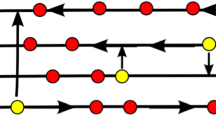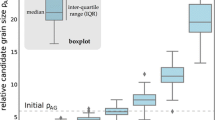Abstract
A two-dimensional (2-D) grain growth simulation, using a curvature-driven vertex model applied to an initially Monte Carlo (MC)–generated microstructure, has been developed for analysis of the topological characteristics of the process, including the rates of different topological events and the effect of these event frequencies on the evolving grain structure. Findings include a constant ratio of the number fraction of disappearing grains to the area fraction swept by the grain boundary of 4/3; constant fractions of boundary sweeping due to grain disappearance (~2 pct), boundary-switching events (~8 pct), and simple boundary motion (~90 pct); and a constant ratio of 1.34 boundary-switching events per grain disappearance. An affinity term was developed to describe the tendency of grains of different edge classes to contact each other or to be involved in different topological events, relative to random behavior. The highest and lowest edge classes, 3 and 12, respectively, exhibited the highest affinity for mutual contact, a 16 times random occurrence, but an affinity of ~0 for contact with themselves. Intermediate edge classes showed an affinity of ~1, random contact, with other classes or with themselves. Few-edged grains showed ~0 affinity for contacting a disappearing trigon or gaining an edge in an edge-switching event, but had a high affinity, approaching 6, for losing an edge in a switching event. Many-edged grains showed the opposite trends and intermediate edge classes showed a random or less tendency for participation in any topological event. It was shown statistically that the growth rate of individual grains is controlled solely by the edge class, with essentially no direct effect from the grain size. The evolution of the grain area and edge class distributions were monitored throughout the transition from transient to steady-state grain growth, with a steady state achieved after loss of approximately 1/3 of the initial grains. The steady-state values of the coefficients of variation (CVs) of the edge class and grain area distributions were ~0.2 and 0.7, respectively.














Similar content being viewed by others
References
F.N. Rhines and K.R. Craig: Metall. Trans., 1974, vol. 5, pp. 413–25.
C.S. Smith: Metal Interfaces, ASM, Cleveland, OH, 1952, pp. 65–113.
W.M. Williams and C.S. Smith: Trans. AIME, 1952, vol. 194, pp. 755–65.
J.H. Steele, Jr.: Microstructural Science, Elsevier, New York, 1974, vol. 1, pp. 283–91.
F.N. Rhines, K.R. Craig, and D.A. Rousse: Metall. Trans. A, 1976, vol. 7A, pp. 1729–34.
F.N. Rhines and B.R. Patterson: Metall. Trans. A, 1982, vol. 13A, pp. 985–93.
B.R. Patterson and V.D. Parkhe: Acta Stereologica, 1987, vol. 6, pp. 407–12.
K. Fuchizaki, T. Kusaba, and K. Kawasaki: Philos. Mag. B, 1995, vol. 71, pp. 333–57.
C.E. Krill and L.-Q. Chen: Acta Mater., 2002, vol. 50, pp. 3057–73.
Y. Saito: ISIJ Int., 1998, vol. 38, pp. 559–66.
F. Wakai, Y. Shinoda, S. Ishihara, and A. Dominguez-Rodriguez: J. Mater. Res., 2001, vol. 16, pp. 2136–42.
K. Brakke: Exp. Math., 1992, vol. 1, pp. 141–65.
D. Juul Jensen, E.M. Lauridsen, L. Margulies, H.F. Poulsen, S. Schmidt, H.O. Sorensen, and G.B.M. Vaughan: Mater. Today, 2006, vol. 9, pp. 18–25.
H.F. Poulsen: Three-Dimensional X-Ray Diffraction Microscopy: Mapping Polycrystals and Their Dynamics, Springer, Berlin, 2004.
V.E. Fradkov, M.E. Glicksman, and K. Rajan: in Modeling of Coarsening and Grain Growth, C.S. Pande and S.P. Marsh, eds., TMS, Warrendale, PA, 1993, pp. 183–94.
R.T. DeHoff and F.P. Cone: in Microstructural Science, I. LeMay, P.A. Fallon, and J.L. McCall, eds., Elsevier, New York, 1979, vol. 7, pp. 425–32.
M.A. Palmer, V.E. Fradkov, M.E. Glicksman, and K. Rajan: Scripta Mater., 2003, vol. 48, pp. 1173–78.
K. Rajan, M. Glicksman, V. Fradkov, M. Palmer, and J. Sweet: in Modeling of Coarsening and Grain Growth, C.S. Pande and S.P. Marsh, eds., TMS, Warrendale, PA, 1993, pp. 217–25.
M.P. Anderson, D.J. Srolovitz, G.S. Grest, and P.S. Sahni: Acta Metall., 1984, vol. 32, pp. 783–91.
D.J. Srolovitz, G.S. Grest, and M.P. Anderson: Acta Metall., 1985, vol. 33, pp. 2233–47.
K. Marthinsen, N. Ryum, and O. Hunderi: in Grain Growth in Polycrystalline Materials III, H. Weiland, B.L. Adams, and A.D. Rollett, eds., TMS, Warrendale, PA, 1998, pp. 71–80.
V. Tikare, E.A. Holm, D. Fan, and L.-Q. Chen: Acta Mater., 1998, vol. 47, pp. 363–71.
D. Weygand, Y. Brechet, and J. Lepinoux: Acta Mater., 1998, vol. 46, pp. 6559–64.
S.P. Marsh, A. Masamura, and C.S. Pande: in Modeling of Coarsening and Grain Growth, C.S. Pande and S.P. Marsh, eds., TMS, Warrendale, PA, 1993, pp. 339–46.
H.J. Frost, C.V. Thompson, and D.T. Walton: in Modeling of Coarsening and Grain Growth, C.S. Pande and S.P. Marsh, eds., TMS, Warrendale, PA, 1993, pp. 271–80.
T.O. Saetre and N. Ryum: in Modeling of Coarsening and Grain Growth, C.S. Pande and S.P. Marsh, eds., TMS, Warrendale, PA, 1993, p. 281–94.
F. Wakai, N. Enomoto, and H. Ogawa: Acta Mater., 2000, vol. 48, pp. 1297–1311.
C. Maurice and F.J. Humphries: in Grain Growth in Polycrystalline Materials III, H. Weiland, B.L. Adams, and A.D. Rollett, eds., TMS, Warrendale, PA, 1998, pp. 81–90.
C. Maurice: in Recrystallization and Grain Growth, G. Gottstein and D.A. Molodov, eds. Springer-Verlag, Berlin, 2001, pp. 123–34.
C.C. Battaile: Sandia National Laboratory, Albuquerque, NM, unpublished research, 2007.
J. von Neumann: in Metal Interfaces, ASM, Cleveland, OH, 1952, pp. 108–10.
C.C. Battaile and E.A. Holm: in Grain Growth in Polycrystalline Materials III, H. Weiland, B.L. Adams, and A.D. Rollett, eds., TMS, Warrendale, PA, 1998, pp. 119–24.
R.D. Doherty: Metall. Trans. A, 1975, vol. 6A, pp. 588–91.
R.T. DeHoff: Acta Mater., 1998, vol. 46, pp. 5175–85.
D.A. Aboav: Metallography, 1980, vol. 13, pp. 43–58.
D. Weaire: Metallography, 1974, vol. 7, pp. 157–60.
A.P. Sprague and B.R. Patterson: University of Alabama at Birmingham, Birmingham, AL, unpublished research, 2007.
Acknowledgments
The authors acknowledge the contributions of many colleagues and students who have contributed to various aspects of the theoretical and simulation development of this study. Of the most importance are the numerous discussions of topology with Dr. Bob DeHoff over the past 30 years. These discussions have provided the foundation and much of the present understanding of the topological nature of grain growth. The pioneering work and ideas of Drs. Fred Rhines and Jim Steele have also pointed the way for much of the present work. Former students contributing to the development of these and related numeric simulations and analyses over the past 20 years, laying the groundwork for this final compilation, include Drs. Vijay Parkhe and Xin Deng. The authors also gratefully acknowledge the financial support for this work through numerous National Science Foundation programs related to microstructural studies of physical processes, including DMR-8306261, DMR-8611611, DMR-9009407, and DMR-9302292.
Author information
Authors and Affiliations
Corresponding author
Additional information
Manuscript submitted April 22, 2009.
Rights and permissions
About this article
Cite this article
Sprague, A.P., Patterson, B.R. & Grandhi, S. Topological Characteristics of Two-Dimensional Grain Growth-Simulation and Analysis. Metall Mater Trans A 41, 592–602 (2010). https://doi.org/10.1007/s11661-009-0139-0
Published:
Issue Date:
DOI: https://doi.org/10.1007/s11661-009-0139-0




